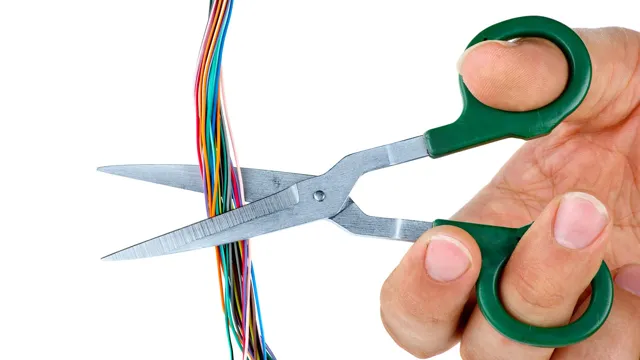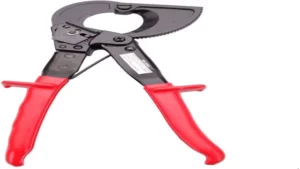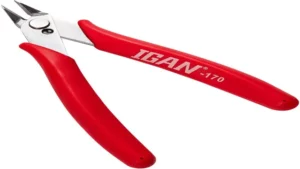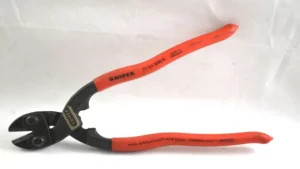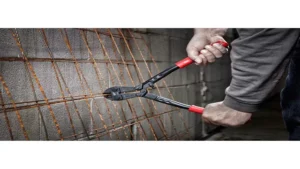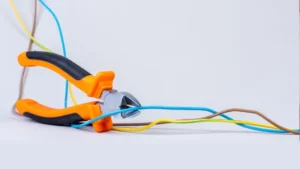Cutting thick wire is a challenge that many of us face at some point. Sometimes, we may not have wire cutters readily available, or the wire is simply too thick for the cutters we have. So, what can we do when we find ourselves in this situation? Is it even possible to cut thick wire without wire cutters? Well, the answer is yes! There are several methods you can use to cut thick wire without the need for wire cutters.
In this blog post, we’ll explore some of the best ways to do it while still achieving a clean, even cut. So, if you’re ready to learn new ways to tackle tough wire-cutting situations, then keep on reading!
Prepare for Cutting
If you need to cut thick wire but don’t have wire cutters, don’t worry. There are a few things you can do to prepare yourself for the task. Firstly, make sure you have the right tools on hand.
You’ll need a pair of heavy-duty gloves to protect your hands from any sharp edges or flying debris. You’ll also need a pair of pliers or vice grips to grip the wire firmly while you cut it. Once you have your tools ready, take a good look at the wire you want to cut.
Check for any twists, kinks, or other irregularities that could affect your cutting ability. If there are any, straighten the wire as best you can before you start. Finally, make sure you have enough space to work in.
Cutting thick wire can be a messy business, so set up in an area where you won’t damage anything important. With these steps completed, you’ll be ready to start cutting your wire with ease, even without traditional wire cutters.
Gathering Materials
When it comes to preparing materials for cutting, there are a few things you need to consider before diving in. Firstly, assess the materials you have on hand and ensure they are suitable for your project. Are they the correct size and thickness? Are they free of any defects or blemishes that could impact the final product? Once you’ve gathered your materials, it’s time to measure and mark out where you’ll be cutting.
Use a straight edge and a sharp pencil to make precise measurements and create an accurate cutting guide. Remember, it’s important to take your time during this step, as any mistakes could be costly and lead to wasted materials. Finally, make sure you have all the necessary tools and equipment on hand before you begin cutting.
Having everything ready to go will make the process smoother and ensure that you can complete the job efficiently and effectively. So, take the time to properly prepare your materials before cutting, and you’ll be sure to create a high-quality finished product.
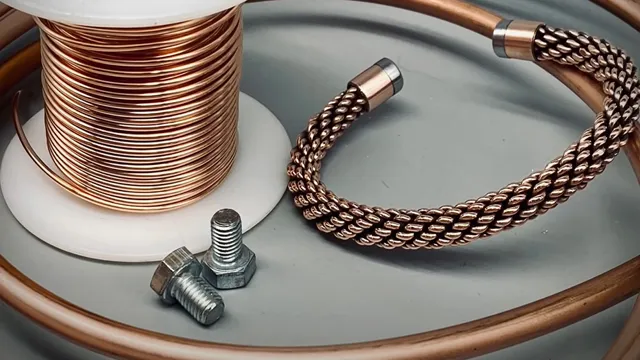
Wearing Protective Gear
When it comes to cutting, wearing protective gear is a must. It’s important to prepare not only the tools you’ll be using but also the gear you’ll be wearing. Protective gear varies depending on the type of cutting you’ll be doing.
For instance, if you’ll be working with wood and similar materials, wearing safety glasses is essential to prevent debris and sawdust from getting into your eyes. Additionally, gloves and long-sleeved clothing can help prevent cuts and scrapes on your hands and arms. If you’ll be working with power tools, wearing earplugs or earmuffs can help protect your hearing.
For cutting tasks involving noise and vibration, wearing earplugs and earmuffs can help protect your ears from hearing damage. The keyword used organically is “protective gear.” Remember that wearing proper gear before starting the task helps to prevent accidental injuries.
Techniques for Cutting Thick Wire
Cutting thick wire without wire cutters can be a daunting task, but there are various techniques that can make it easier. One such method is using a hacksaw blade, which can easily cut through even the toughest wire. Simply clamp the wire securely in a vise, then use the hacksaw blade to saw back and forth until the wire is cut through.
Another technique is using a bolt cutter, which is specifically designed for cutting thick wires or bolts. The jaws of a bolt cutter are much stronger than those of regular wire cutters, making it an effective tool for cutting thicker wires. However, it’s essential to ensure that the wire is adequately secured in the bolt cutter before attempting the cut.
These are just a few techniques that can be used to cut thick wire without wire cutters. With a little practice and patience, even the toughest wires can be cut with precision and ease.
Using a Handsaw
When it comes to cutting thick wire with a handsaw, there are a few techniques that can make the job much easier. First of all, it’s important to choose the right saw for the job. A crosscut saw with large, sharp teeth is ideal for cutting thick wire, as it will make quick work of the metal.
Hold the saw firmly with both hands, and keep the blade at a 45-degree angle to the wire. This will help prevent the blade from binding, which can be a common problem when cutting thick wire. Another technique to keep in mind is to use long, smooth strokes when sawing.
Short, choppy strokes can cause the saw to dig into the wire, making it difficult to make a straight cut. Finally, take breaks often to rest your arms and hands. Sawing through thick wire can be a tiring job, and it’s important to give yourself plenty of time to rest between cuts.
With these techniques in mind, cutting thick wire with a handsaw can be a breeze.
Using a Hacksaw
If you need to cut thick wire, using a hacksaw is a great option. There are a few techniques you can use to make sure you get a clean cut. First, make sure you have a blade with the appropriate number of teeth per inch (TPI) for the thickness of the wire.
A blade with too few TPI will leave a rough edge, while a blade with too many TPI will dull quickly. Next, use a vise or other clamping mechanism to hold the wire securely in place. This will help prevent the wire from bending or vibrating during the cut, which can also create a rough edge.
Finally, take your time and use even pressure as you saw through the wire. If you try to rush or use too much force, you may end up with a jagged or uneven cut. With a little practice, you’ll be able to make smooth, precise cuts with a hacksaw every time.
Using Bolt Cutters
Bolt cutters are an effective tool for cutting thick wires. However, it is important to learn the right techniques to ensure safety and efficiency. When using bolt cutters, position the wire as close to the hinge of the cutters as possible for maximum leverage.
Use your dominant hand to grip the handles and your other hand to stabilize the wire. Apply firm pressure and use a rocking motion to make the cut, rather than trying to force the blades through the wire with a single motion. Additionally, make sure to wear protective gloves and eye gear to prevent injury and always use the appropriate size of bolt cutters for the wire you are cutting.
With these techniques and precautions, you can successfully cut thick wires with bolt cutters.
Using Scissors
Cutting thick wire can be a challenge when only scissors are available for the job. However, with the right techniques and a bit of patience, it can be done. One such technique is using the serrated edge of the scissors.
This edge is designed to grip and cut through tough materials and can be used to saw through the wire. Another technique is using a diagonal cutting plier. This tool has a sharp blade that can make clean cuts through thick wire.
However, it’s important to use a plier with a cutting capacity that matches the thickness of the wire. It’s also essential to wear protective eyewear and gloves as bits of wire can fly off during the cutting process. With these techniques, cutting thick wire with scissors can be an effective solution when other tools are not available.
Avoiding Defects
Have you ever found yourself in a situation where you need to cut thick wire, but don’t have wire cutters on hand? While it may seem daunting, it is possible to cut thick wire without wire cutters. One way to achieve this is by using a small hacksaw. Simply mark the wire where you want to cut it and use the hacksaw to carefully cut through the wire.
Another option is to use a pair of pliers. Lock the pliers onto the wire where you want to make the cut, then twist the pliers back and forth until the wire snaps. While these methods may not be as simple as using wire cutters, they can be effective in a pinch.
Just be sure to exercise caution and wear protective gear to avoid injury or defects.
Creating a Clean Cut
Creating a Clean Cut when crafting anything, be it wood, fabric or metal, is important to avoid defects. These defects could be anything from jagged edges, splintering to warping of the material. Therefore, it is essential to choose the right tool for the job, to have a sharp blade or implement, and to use the right technique.
One of the most common mistakes people make is to use a blunt or worn-out tool. Not only can this affect the quality of the final product, but it could also put the user at risk of injury. It is also important to pay attention to the angle of the blade or tool.
The slightest error could cause the material to warp or become uneven. So, the key to creating a clean cut is to choose the right tool, ensure it’s sharp, and use the right technique. This will result in a defect-free material that is ready for any project.
Choosing the Right Tool
When it comes to choosing the right tool for any task, it can be easy to get overwhelmed by the plethora of options available. However, selecting the wrong tool can lead to defects and subpar results. So, how do you avoid this outcome? First, consider the specific needs of your project and do your research to find a tool that fits those needs.
Don’t just go for the most popular or cheapest option without taking a closer look. Additionally, don’t be afraid to test out different tools and see which one works best for you. It’s better to invest a little extra time upfront to avoid costly defects down the line.
By taking your time and doing proper research, you can choose the appropriate tool for your task and avoid the headaches of defects.
Conclusion
In summary, cutting thick wire without wire cutters requires creativity, determination, and a touch of MacGyver-esque ingenuity. Whether you’re using a hacksaw, bolt cutters, or even your teeth (not recommended), the key is to think outside the box and come up with an unconventional solution. So, the next time you find yourself in a bind and need to cut some thick wire, don’t panic – just remember to channel your inner MacGyver and get those wires snipped with style!”
FAQs
Is it possible to cut thick wire without wire cutters?
Yes, it is possible to cut thick wire without wire cutters. There are various methods that can be used, such as using a hacksaw, a rotary tool with a cutting wheel, or even pliers.
What is the best way to cut thick wire without wire cutters?
The best way to cut thick wire without wire cutters would depend on the specific tools and materials available. However, using a hacksaw with a fine-toothed blade is generally considered a good option.
Can scissors be used to cut thick wire?
It is not recommended to use scissors to cut thick wire, as they may not be able to handle the thickness and could become damaged or even break.
Is it safe to cut thick wire without wire cutters?
As long as proper safety procedures are followed and appropriate tools are used, it can be safe to cut thick wire without wire cutters. However, caution should always be taken when working with sharp or heavy objects.
What types of wire can be cut without wire cutters?
While wire cutters are specifically designed for cutting wire, many other tools can also be used depending on the thickness and material of the wire. For example, scissors can work for thinner wires, while bolt cutters may be needed for thicker, heavy-duty wires.
Can a Dremel tool be used to cut thick wire?
Yes, a Dremel tool with a cutting wheel can be used to cut thick wire. However, it may take longer and require more precision than other tools like a hacksaw or bolt cutters.
What should be done if wire cutters are not available?
If wire cutters are not available, various common household tools can be used to cut wire, such as pliers, scissors, or even a knife or razor blade (with extreme caution). However, caution should always be taken and appropriate safety measures should be followed.
